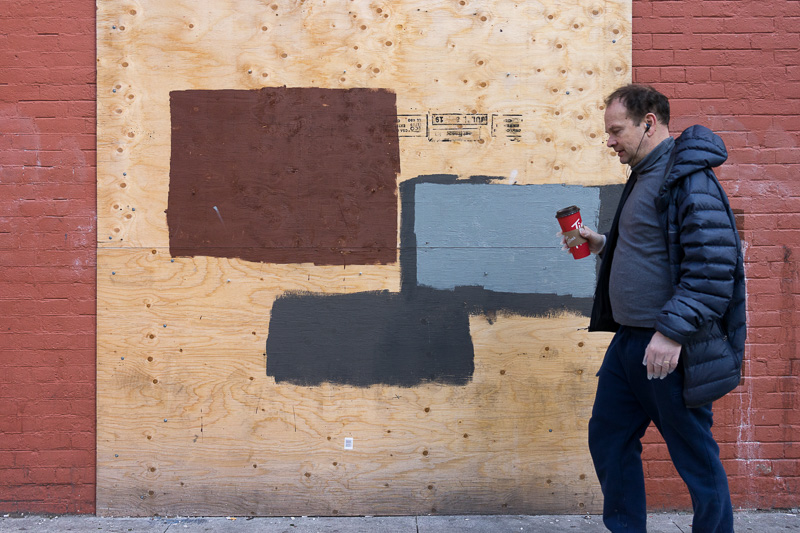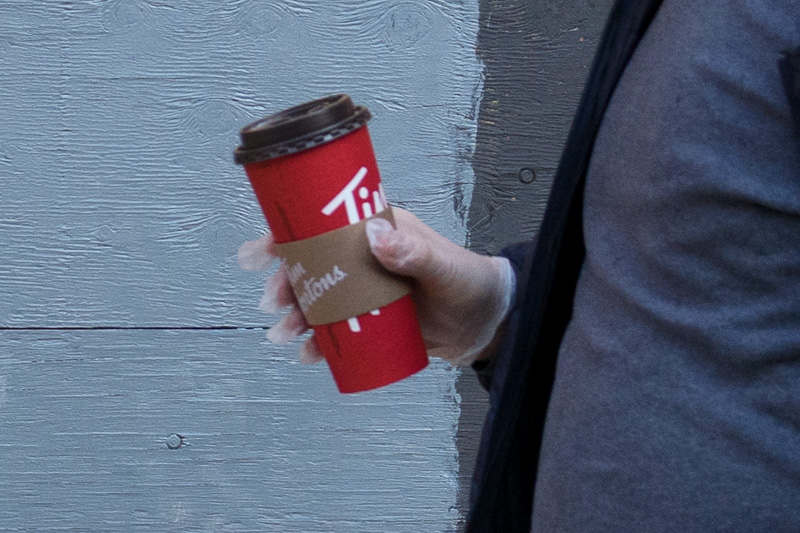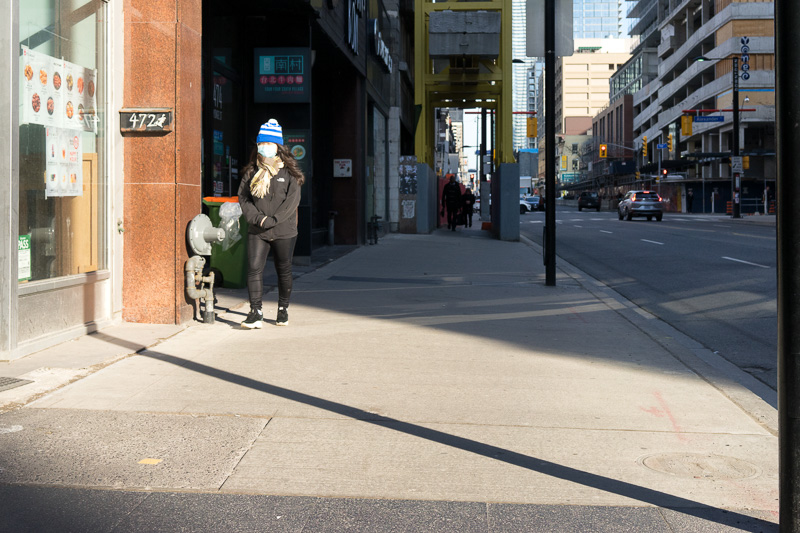
It’s been a helluva week!
This blog preoccupies itself with the power of images and words. Yet, as I post about my latest street photography adventure or comment on the latest novel I’ve read, the question sometimes arises: how much should I allow the broader sweep of world events to impinge upon my narrower concerns? Like most questions I pose to myself, the answer that returns to me is: it depends. On the one hand, it’s tempting to say of a work — whether a photograph, a poem, a novel, or a song on Spotify — that it needs to be judged on its own merits; if it can’t stand on its own, then it really isn’t worth the bother. On the other hand, the countervailing view is that nothing exists in a vacuum; it only becomes meaningful as we hold it in dialog with its context.
Consider the photograph above:
The exif file tells me I shot it at 9:40 on Monday morning. Does anyone need to know this? I was tired. We had just switched to daylight savings time. I had gotten up at 4:30 am (which was really 3:30 am) to go with my wife to a medical appointment. At 6 am, we ate breakfast at Fran’s. I remember that the table was sticky. At 7 am, we went to a the Starbucks in the TD Centre and observed the sign announcing that, out of concern for Coronavirus, Starbucks would no longer provide coffee in refillable mugs. (This raises an obvious question that nobody seems to be asking: if the use of refillable mugs poses such a risk for the transmission of infectious diseases, why was Starbucks doing it in the first place?) After coffee, my wife went to work. I rode an elevator to street level with a woman who refused to touch the button until she had wrapped her finger in Kleenex.
From there, I began my usual photographer/flaneur routine through the rush hour crowds. On my way home after rush hour, I passed a plywood board fixed to a wall and said to myself: Oh look, an inadvertent Rothko! I took a series of shots, both of the plywood alone and with people passing through the frame. Ten minutes earlier, the markets had opened to a tremendous crash. By the end of the day, the TSX closed down 1,661 points, the single largest loss recorded since the Black Monday of October 19, 1987. I had not noticed at the time, but when I got home and examined my photographs more closely, I saw that, in one photograph, the man passing through the frame was holding a disposable coffee cup while wearing disposable plastic gloves.
Imagine viewing this photograph ten years from now when the Covid-19 pan(dem)ic is all but a distant memory. Without context, the disposable coffee cup is neither here nor there. Viewers might not even notice the plastic gloves. On a casual glance, the photo may have nominal interest. It’s significance only emerges when we dredge up its accompanying baggage.

What will count as reasonable context? Ten years from now, will we remember the panic that gripped us this week? Will we remember the rush to sell stock and to stock toilet paper? Will we remember the unexpected acceleration from a blasé denial to full-on panic that followed Wednesday’s typically inept statement from the Oval Office? This prompted an even greater sell-off on Thursday, with a drop on the TSX of 1,762 points, the single worst day since 1940. Will we remember the irony of how people, afraid they would be subject to quarantine, packed themselves by the hundreds into grocery stores? Will we remember the buzz in the air? The tingle of excitement? Maybe that was the virus saying hello.
To project ourselves into the future, it might be useful to remind ourselves of how we stand in relation to the past. The comparison to SARS is inexact, but it may still offer guidance. While it is apparent that SARS had nowhere the reach of Covid-19, nevertheless because Toronto was particularly affected, its experience is worth considering. First, a comparison of market performance is impossible, and for a number of reasons. Because SARS was not as widespread, it was not perceived as a global threat and had little disruptive effect on most major exchanges. In addition, its outbreak in China in November, 2002 was one month after the U.S. launched its war in Iraq. It would be difficult to isolate the effects of SARS on the markets when a major military campaign was unfolding. By July, 2003, the WHO declared SARS contained and the last case was reported in January, 2004. No one discovered a cure or vaccine for SARS, which is a form of coronavirus.
Another difference in the experience of SARS is that social media as we now know it did not exist and so there was no instantaneous dissemination of both information and misinformation. People learned of the illness and appropriate protocols through newspapers or nightly newscasts on TV, and they had fewer ways to amplify personal responses like anger and panic. Nevertheless, at least in Toronto, certain habits became ingrained and have persisted as part of our local culture: ubiquitous hand sanitizer dispensers, coughing into the crook of the elbow. One wonders of the same thing will happen with Covid-19. After the WHO declares Covid-19 contained, everybody will continue to carry hand sanitizer as a matter of course and will provide it to house guests on entry. Everybody will wear face masks which means kissing will be an act of rebellion that marks out the perpetrators as anarchists; people will look at Alfred Eisenstaedt’s famous V-J Day kiss photograph and it will fill them with disgust. No one will shake hands anymore, substituting some other gesture, like bumping elbows. Hugging, of course, will be a distant memory. And all those who can afford it will keep special rooms in their homes, like wine cellars, but dedicated to the storage of rare toilet papers.
